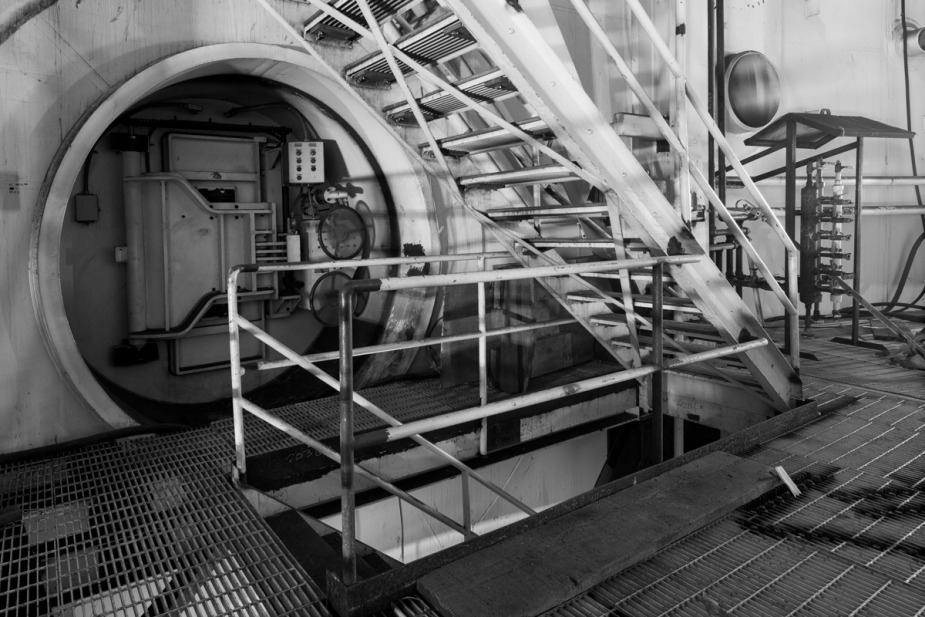Sun beams break through the redwoods at the Henry Cowell State Park near Santa Cruz, California.
In a few hours I'm hoping on a plane to visit family. Have a great week and enjoy whichever holiday you celebrate!

Sun beams break through the redwoods at the Henry Cowell State Park near Santa Cruz, California.
In a few hours I'm hoping on a plane to visit family. Have a great week and enjoy whichever holiday you celebrate!

Dental station at the former U.S. Marine Hospital in Tennessee.
The U.S. Marine Hospital's main building was constructed in the 1930's, replacing the fourty-year old original building.

Second floor room at the U.S. Marine Hospital in Tennessee.
I am slowly running out of hospital and asylum images to post and the next big trip isn't until Spring. It's starting to get to me. I need a fix.

Staircase in the Safe Cabinet Company admininstration building in Ohio, constructed in 1905.

The nurses' quarters at the U.S. Marine Hospital in Tennessee were constructed in the late 1800's, with the original hospital, and moved 100 feet in the 1930's when the new hospital building was constructed.

Patient rooms at dawn, South Carolina Lunatic Asylum.

Personnel entrance to the Nuclear Reactor Buidling at the Satsop Nuclear Power Plant.
Construction on the Satsop Nuclear Plant began in 1977, but was halted five years later due to budget issues. The site was maintained as though construction would resume, but in 1993, the project was cancelled. The plant now sits 76% completed, but has been repurposed by a number of businesses, including NASA.

I met up with a few photographers in Santa Cruz for a photowalk on Saturday. We had a great morning shooting in the redwoods, but I wasn't able to stay for the sunset. I began the drive home on Hwy 1 and made a quick stop at the lighthouse when I noticed the sky collecting color.

It's often hard for others to comprehend my interest in morgues. To most, morgues are considered depressing, gross or creepy. While I recognize these morgues resemble something many of us are afraid of, death, they are much like an endangered species that you have been lucky enough to stumble upon.
When many of these asylums close, they often begin to experience foot traffic by kids, explorers, scrappers and taggers. For some reason morgues seem to be where people gravitate when they explore these hospitals. Sometimes scrappers will have taken the metal parts, but most often I find that taggers have put their names all over the tile walls and morgue doors, which to me, generally makes the morgue unworthy of a photograph. It is incredibly rare to find a complete morgue, undisturbed for decades.
This morgue was in a pitch black basement. To light the scene, I used 3 flashlights: one bounced inside the hood (cool LED), one out of frame to the left (incandescent) and one out of frame to the right in the hallway (also incandescent.) My hope was to convey a natural looking scene, rather than something that appeared to have been light painted.

Wind turbines near Palm Springs, California.
(Night. 90% moon. 5 minute exposure.)

Inside this dark building, located near the water in the Ammunition Depot of the former Mare Island Naval Shipyard, sits banks of battery charging stations. Sadly, there is little information published about most of the buildings in this section of the shipyard. I am not certain what the batteries were used for, but a number of signs point towards a forklift charging station and maintenance building.
Base facilities included a hospital, ammunition depot, paint and rubber testing laboratories, schools and four drydocks. During WWI and WWII, the shipyard constructed almost ninety vessels.

The Safe Cabinet Company began in Ohio in 1905. The company manufactured safes and was in operation for 20 years before merging with The Rand Company, to form Remington Rand in 1927.
The Safe Cabinet Company headquarters in Marietta, Ohio was comprised of a a series of large multi story warehouses and a beautiful administration building constructed with large columns at the front entrance. The front half of the building contained multiple stories of offices, while the rear boasted a theatre, spanning from the basement to the second floor of the complex.

Stairway leading to the attic of the Babcock Building at the South Carolina Lunatic Asylum.
The Babcock Building, known for its red roofed cupola, was constructed between 1857 and 1885 in the Italian Renaissance Revival Design and was added to the National Register of Historic Places in 1981.

Corridor inside the former U.S. Marine Hospital on the Mississippi River in Tennessee.

Splash is a water-dwelling dinosaur, who plays in shallow streams all across the Pacific Northwest.